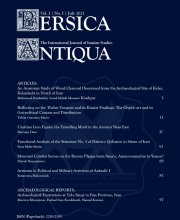
مقالات
حوزههای تخصصی:
Rabat Tepe, an ancient site in northwestern Iran near the Little Zab River, reveals insights into two distinct periods from the Iron Age. The primary focus of excavations has been on the layers dating back to the first millennium BC. Notable discoveries at Rabat include a striking pebble mosaic pavement, fortified walls, and various decorative bricks. The site’s size, architectural remains, and uncovered artifacts point to its significant role during the first millennium BC. Through multiple excavation seasons, researchers have gleaned valuable information about the site’s layout and historical eras. Evidence suggests that a thick wall once enclosed the entire area, around 3 meters in width. Artifacts found at Rabat share similarities with those from Qalaichi, a well-known Mannaean site. While initially attributed to Mannaean culture, this association is now under debate. Excavations between 2006 and 2008 unearthed inscribed bricks inscribed with Neo-Assyrian cuneiform script. These findings sparked discussions and identified Rabat with ancient cities like Paddir/Šurdira and Hubushkia, although these identifications face significant challenges. Rabat was an independent religious-royal city-state.
Hyrcania and the Eastern Borders of Median Kingdom(مقاله علمی وزارت علوم)
حوزههای تخصصی:
The Territorial conquests of the Medes, as Far East as Hyrcania, could be traced from the first half of the seventh century BC onwards. The first Median kings undertook far-flung campaigns to take control of the region and extend their territory. The existence of the fortified settlement in the Gorgān plain could prove the expansion of centralized Median kingdom as far as Hyrcania. The Assyrian sources of the 9th to 7th century BC are also in overall agreement with the results of the archeological studies in the western steppe of Gorgān plain (Hyrcania). As a result, the Median’s dominance over Hyrcania determined the strategies and political guidelines of the Median kingdom and set the foundations for its transformation from a confederation of tribes to a powerful trans-regional state. Accordingly, in the present paper, beside historical and literary sources, archaeological evidences have also been studied in order to determine the Median’s range of territory in the east of their homeland.
The New Interpretation of the Scene of “Šābuhr Killing Deer” on the Sasanian Silver Plate from the British Museum(مقاله علمی وزارت علوم)
حوزههای تخصصی:
The silver plate from the British Museum (inv. 124091) usually attributed as depicting “Šābuhr killing deer”does not have a direct parallel in Sasanian iconography. The attempts were made to explain the image in perspective of relation to Mithraism, however no detailed analysis was done. The plate represents features typical for the Sasanian silver but, at the same time it is modelled upon Mithraic tauroctony. This makes the scene a possibly important argument in discussion regarding the very existence of Iranian Mithraism. The fact that the scene is not a direct copy of the Roman tauroctony arguments for association with Iranian imagery. The scene had to be understood in Iranian terms, despite referring to Roman depictions. This supports the view of Iranian, pre-Zoroastrian Mithraic cult.
Stone and Water: A Case Study of Integrated Hydraulic Structures within the Late Antique Monumental Architecture of the Bozpar Valley in Southern Iran(مقاله علمی وزارت علوم)
حوزههای تخصصی:
This paper presents the results of a geoarchaeological study of the ancient hydraulic structures in the Bozpar Valley and an analysis of their relationship with the standing monuments, especially the two palatial structures known as Kushk-e Ardashir and Zendan-i Soleyman. It presents a raison d’être for each identified structure regarding its hydraulic function and physical integration within the monumental landscape. Then, it suggests an interpretative pattern in their spatial relation to the mentioned monumental structures. The study area is a small and remote valley in the Zagros highlands in southern Iran. It borders the modern provinces of Fars and Bushehr and is historically associated with the Greater Fars region. The monumental structures in this area belong to the Sasanian architectural tradition. Here, their integrated hydraulic structures are investigated interdisciplinary via remote sensing. The analysis indicates different functions for the two monuments: a representative and official kushk and a [seasonal] leisure palace. Based on the nature and function of the integrated hydraulic structures, the former monument seems to relate to food production activities and the latter to currently unidentified activities other than daily life. The results of this study provide further evidence of integrated hydraulic structures in Late Antique Iran and shall trigger comparative studies from neighbouring regions in the future.
Archaeology of the Persian Gulf(مقاله علمی وزارت علوم)
حوزههای تخصصی:
For years, archaeologists have investigated and excavated the peripheral lands of the Persian Gulf and accomplished considerable achievements in this regard. The findings were published in the form of articles and books. Nevertheless, despite efforts by some historians to come up with works on this field, there lacks a comprehensive archaeological book on the Persian Gulf. In the present study, the author attempts to critically evaluate a book entitled Persian Gulf Archaeology in Parthian & Sasanian Periods.